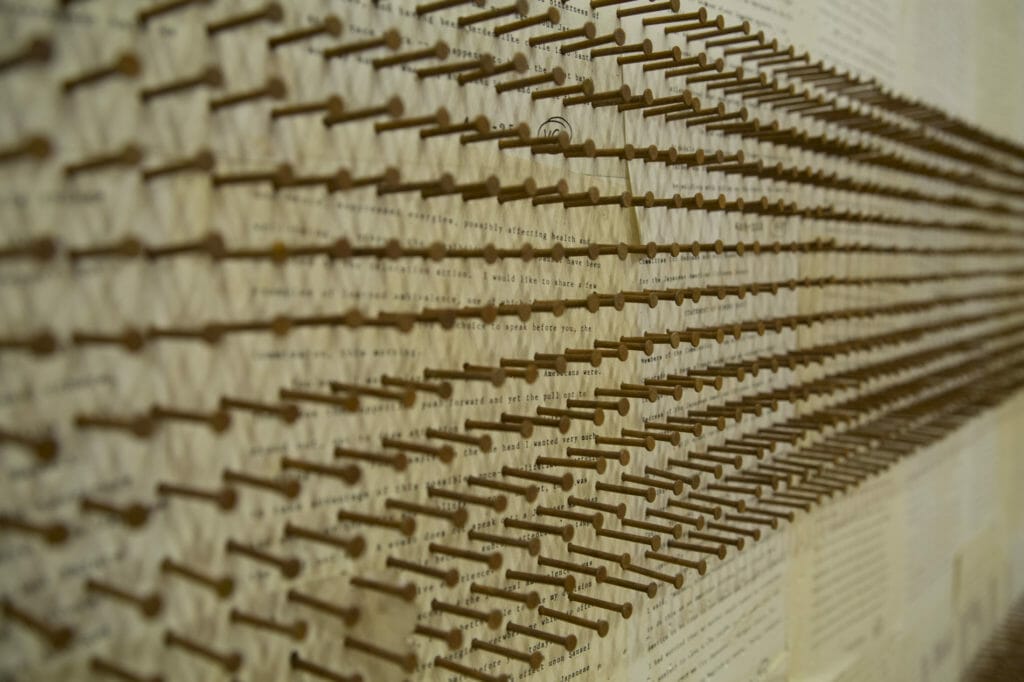Do you remember?
This question reverberates through the Block Museum’s latest show titled If You Remember, I’ll Remember. Curated by Janet Dees, this exhibition at the Mary & Leigh Block Museum of Art in Evanston invites viewers into a room of precious objects, each handcrafted with care. The exhibition draws us into narratives of sorrow, mourning, healing, and hope. Though the show only features works by five individual artists and one artist pair, it’s a marathon. Poeticism abounds and each piece lingers with the viewer long after leaving.

NO ONE HAS A MONOPOLY OVER SORROW
The show begins not with a bang, but with a whimper.
A dried bed of flowers cradle melted bullet coated fingers from men that fought in American wars. This moment of graceful mourning sets the tone for the show.
THE NAIL THAT STICKS UP THE FARTHEST
Kristine Aono’s installation is a haunting highpoint of the show and a museum rarity—you can touch it. The artwork asks us to place a nail in one of the thousands of holes on the board, representing every Japanese-American interned. Drawing towards the work to place a nail, you are engulfed by memories—letters from her Japanese American grandfather who had been interned during World War II and the testimonies from other internees cover the board. On either side of the American flag made with nails, reads the ominous phrase “The Nail That Sticks Up the Farthest, Takes the Most Pounding.”
PRAYERS FOR OUR CHILDREN
Midway in the exhibition, baskets carefully woven by the Eastern Cherokee artist Shan Goshorn pepper the open floor plan. One basket shimmers in shades of blue and turquoise. In this sea of blue, white star-like shapes pattern the basket and a large sepia square is featured on one side. Taking a step closer, the blues, turquoises, whites, and sepia colors come into focus. Upon closer inspection, this bright blue basket is made up of various historical documents: the sepia rectangle is an image of Native American children attending a boarding school that aimed to forcibly assimilate them and words on the woven strips of blue bear prayers of healing for these children.
HERBARIUM
An herbarium preserves, collects, and catalogues. In Herbarium: A historic reflection inspired by the Mason family collection (2015), Samantha Hill crafts her own historical herbarium, connecting the violence against African Americans in the past to the present. Every element of the work is made and measured with care—the golden frames, the typed cards, the carefully measured pieces of twine.
In this image, we see Hill connecting the bombing of the 16th Street Baptist Church by the Ku Klux Klan in 1963, which killed four young African American girls, with recent incidents of police brutality against young African Americans.
WITNESS
The finale, a large wool blanket swinging gently from the ceiling, offers a hopeful crescendo. Atop this rhythmically striped blanket, Marie Watt has embroidered an image of a Quamichan tradition called a potlatch, which were banned in Canada and the United States from the late nineteenth until the mid-twentieth century. Looking out from this traditional act of coming together, the artist’s daughter stares out at the viewer—What is she asking of us?
All the works in the exhibition ask the viewer to consider our troubled collective past, yet these crushing histories are interrupted by moments of beauty and hope.
Don’t miss this timely and poignant show.
RECOMMENDED
Top Pick For: Museum Dwellers
Not recommended for: Those looking for easy entertainment
When:
On exhibit through June 18, 2017.
Monday: CLOSED
Tuesday: 10AM - 5PM
Wednesday: 10AM - 5PM
Thursday: 10AM - 8PM
Friday: 10AM - 8PM
Saturday: 10AM - 5PM
Sunday: 10AM - 5PM
Where:
Mary and Leigh Block Museum of Art, 40 Arts Circle Drive, Evanston, IL









